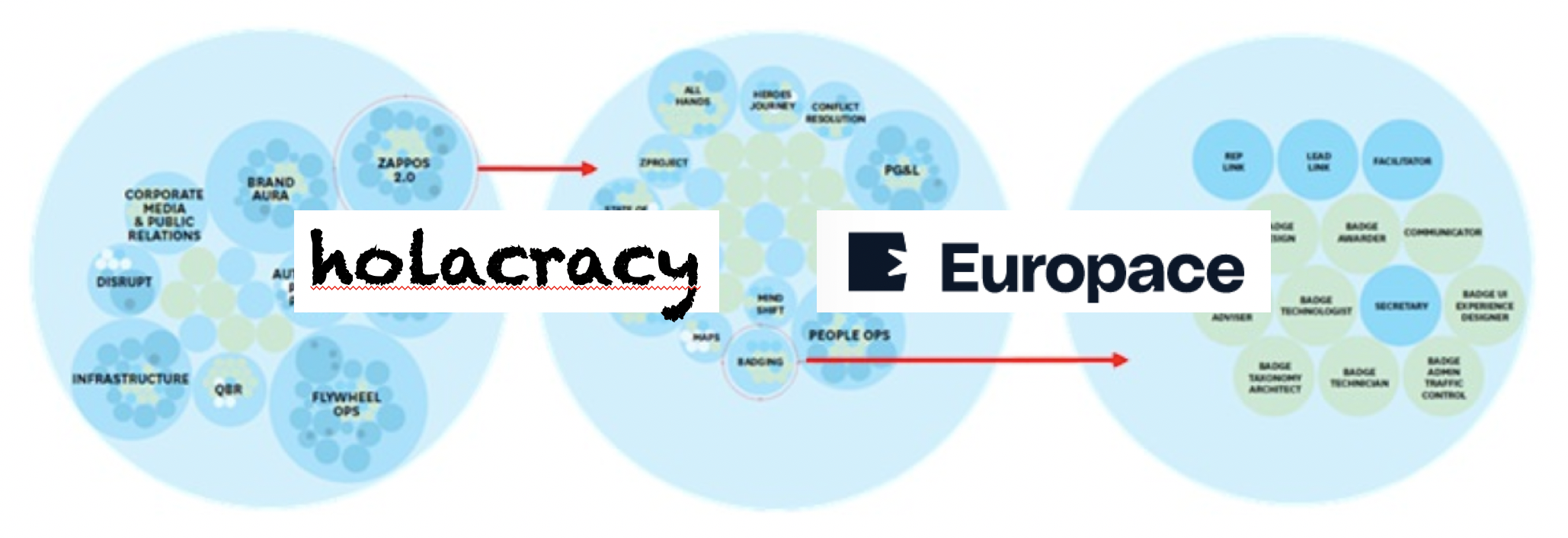Holacracy in the Spotlight: Interview with Thomas Heiserowski, Europace
This late summer I had the great pleasure of talking to Thomas Heiserowski for over three hours. Thomas is one of the two managing directors of Europace. As a subsidiary of Hypoport AG, the fintech brokers construction financing and instalment loans.
As part of my work, I am always looking for opportunities to ask companies about their very personal story of organisational development. The intent behind these interviews is to understand individual differences and to discover new patterns. I was curious about Europace because they are one of the larger companies in Germany that have adopted holacracy and like to stick with it. Holacracy is a particularly elaborate form of self-management – you can read an introduction here, for example.
Normally I do these interviews “for my own record” – but this time we agreed to publish a few interesting perspectives from our conversation.

How did holacracy come about at Europace?
The actual trigger was software development: in order to master complexity, it is necessary to think from the customer’s point of view. Among other things, this requires structured bottom-up decision-making. Due to individual preferences of Thomas and some other Europace employees, as well as due to the experiences from some exciting but ultimately failed isolated experiments, the question came up: Why not fundamentally work in a different way?
I found the first steps of the introduction especially exciting: They started with untargeted “teaser” seminars for a good third of the staff, in which the mechanisms of self-organisation were introduced. This arouse curiosity, and was followed by one or two posts from the management, which put the topic up for debate, as well as a two-day “Tell me why it wouldn’t work” seminar. This was the starting point for a structured introduction of the core element of holacracy: circles – originally planned step by step, but then effectively for all at once, because everyone wanted to jump on. Afterwards, the process continued in a more “classical way” – supported by external and internal consultants, by a clear, common inner attitude of the management, by a clear circle of supporters and by the successes along the way.
What looks different than in “traditional” companies?
At first glance, the division of departments looks almost as usual. Only at second glance do more profound differences become apparent: individual employees have several roles instead of just one, the core functions are deeply integrated into the operational work, the company is very good at dealing with ongoing changes, and decision-making essentially lies with the individual teams. From the customer’s point of view, changing contact persons are noticeable, there is less reliance on “the bosses”, employees without titles are contact persons, and there is more intensive cooperation.
In particular, I would like to emphasise the handling of the extended management circle as food for thought. There is a lot of discussion about what becomes of “middle management” in self-managing organisations. Leaders do not disappear just because jobs are abolished – that is my experience. They just manifest themselves differently, more informally, through competence, commitment and other ways. The essential question is: How can I involve them? In smaller groups, these personalities can act individually. To use their impact for the whole, larger organisation, they need a certain “institutional” anchoring. Europace has started to build a “strategy circle”, which is not as clearly structured as other circles. It is a forum where these leaders find space to drive things forward together – there where there are gaps or is space for ideas.
How are the demands on the employees changing?
This question has perhaps given me the most impetus. Each individual must be able to see and say what he or she needs – for that I need a good understanding of my own desires and capabilities. Especially as a younger employee, I need role models from whom I can learn. Everyone deals with freedom differently.
All these topics are all high demands, how can you organise them? Thomas says: “You have to know the implications you are bringing on board with this organisation”. Employee development – in completely different dimensions – is becoming essential for survival. Europace has a full-time psychologist, invests a lot in mentors and coaches, as well as in regular professional training and reviews. At the same time, it remains a permanent challenge.
What remains for the future?
A few challenges have already been mentioned: Leadership circle or staff development. Beyond that, similar issues can be found as in other companies: Vision, strategy, metrics, product development. Holacracy does not solve issues by itself, but rather points out problems and offers other ways to solve issues. Vision and strategy, for example: the need for a clear, common North Star increases because teams work more autonomously. At the same time, mistrust and aversion to this direction giving also increases because it potentially limits autonomy. Good metrics remain just as much a hard nut to crack as anywhere else – it’s just less easy to “muddle through” with metrics that aren’t good enough. And holacracy has no remedy for good product development planning either.
This interview confirms for me that there is no such thing as the “right” organisational form. Instead, the path depends on one’s own attitude: How do I want to live in my organisation? And am I prepared to accept the consequences and work hard at it?
What is important to you for your organisation? What would you have to tackle for it? And what is stopping you from going down this path?


